|Australia home|
|Sydney, Blue Mts|
|diving Great Barrier Reef|
|Outback|
|Litchfield & Kakadu|
|Singapore|
Click on one of the links above (or in the map)
for more details on any particular area we visited. On this
page, you'll find the following (links within this page):
Description of our trip to Fraser Island,
and of whale watching in Hervey Bay.
Where we stayed (hotels, caravan parks)
Operators for our trips
Photographs - a little larger than
the ones you see in the description of the trip. (I put the
photographs at the end of this page, so they'll load as you read.)
Description of our trip: Fraser
Island, whale watching in Hervey Bay
Wednesday, september 4th, 2002.
Steve, our guide for the duration of our Fraser Island trip, picked us up at eight in the morning. Our "group" consisted of only seven tourists: two retired Australian couples, a retired American, and Eric and I. Although I had a few misgivings at first, the retirees were very friendly, and Steve was absolutely great. He succeeded in spewing a constant stream of very interesting information dotted with a lot of humor. We took the ferry ("barge") from outside Hervey Bay to Fraser Island, and took a 4-wheel-drive bus with huge tires onto the island.
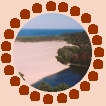 Fraser Island, or Fraser "Oyland" as it's pronounced around here, consists entirely of sand - it's little more than a huge sand bar, really. The sand is washed northward from the New South Wales coast, so that the island is still growing at a slow pace. The sand calls for a specific type of plants, that are suited to this poor soil. The soil does have many
minerals, but it's only at the older parts of the island that decomposing plant growth is starting to give any nutrients to the soil. Many plants and animals are unique to this island, which is why parts of it are protected. For example, there's the towering Satinay tree, the lumber of which was used in the Suez canal, and there's the Fraser Island Funnelweb Spider, which is deadly (and there's no antidote).
Fraser Island, or Fraser "Oyland" as it's pronounced around here, consists entirely of sand - it's little more than a huge sand bar, really. The sand is washed northward from the New South Wales coast, so that the island is still growing at a slow pace. The sand calls for a specific type of plants, that are suited to this poor soil. The soil does have many
minerals, but it's only at the older parts of the island that decomposing plant growth is starting to give any nutrients to the soil. Many plants and animals are unique to this island, which is why parts of it are protected. For example, there's the towering Satinay tree, the lumber of which was used in the Suez canal, and there's the Fraser Island Funnelweb Spider, which is deadly (and there's no antidote).
The colonists named it Great Sandy Peninsula, and lateron Great Sandy Island when they found out it was an island. Then a ship full of colonists stranded on the island. The captain's wife, Eliza Fraser, survived with the help of Aborigines that lived on the island, and the island was named for her and her husband.
We took a walk along Wanggoolba Creek, close to the Central Station. "Central Station" has nothing to do with public transportation, but is the Central Forestry Station - Fraser Island was important for forestry (particularly the Satinay trees) for a while. Wanggoolba Creek is so clear that we didn't even see it at first, and - very remarkable - there isn't a rock on the island, which means that the creek makes no sound! Very unreal.
In the afternoon we took a nice walk to Lake Wabby. Walking up from the beach, through the loose sand, was a little tough for some people (two steps up, slide one step back), but the way down was a cinch. Lake Wabby is a so-called "window lake," a window (or hole) into the water-table. At this point on the island, the ground water reaches up to the top of the lake. Apparently, the sand of Fraser Island holds a lot of water - so much, in fact, that the water flowing through Wanggoolba Creek fell as rain some eighty years ago! According to Steve, it would take 27 years of drought for the creeks to dry up. While most of the rest of our group settled down at the lake, Eric and I walked up to Lookout Point that gave a fantastic view of the lake and the sand dunes leading down to the sea.
We spotted a White-breasted Sea Eagle (?) close to Lake Wabby, and swam in the lake among 30 cm (1 foot) long codfish. At the shallow end of Lake Wabby we also saw three small turtles. Fraser Island's main traffic route is the eastern beach, which is 66 miles long, and named "75 mile beach." As we rode the bus back down to Eurong Beach Resort, where we were staying, we saw a couple of dingos on the beach. From what I heard, a dingo fatally bit a boy last year, so everyone is strongly advised to leave the dingos alone.
We spent the evening in the bar at the Eurong Beach Resort, with a couple of Aussies teaching us the unintelligible words to the song "Down Under" by Men at Work.
Thursday, september 5th, 2002.
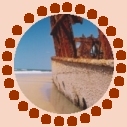 In the morning we visited the Cathedrals, a few colorful sand mounds, and the wreck of the Maheno. The Maheno was a passenger ship, which was sold to the Japanese for scrap metal in 1935. As the Japanese were towing it to Japan, they got caught in a storm, and the ship stranded on Fraser Island; they never got it to budge again. The Japanese removed everything removable from the ship, and left the hulk on the beach for the tourists to come and see.
In the morning we visited the Cathedrals, a few colorful sand mounds, and the wreck of the Maheno. The Maheno was a passenger ship, which was sold to the Japanese for scrap metal in 1935. As the Japanese were towing it to Japan, they got caught in a storm, and the ship stranded on Fraser Island; they never got it to budge again. The Japanese removed everything removable from the ship, and left the hulk on the beach for the tourists to come and see.
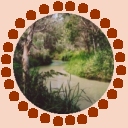 The next stop was Eli Creek, a beautiful, clear creek that runs silently through a patch of rainforest. It was like a very slow rollercoaster: we got into the (pretty cold) water a ways upstream, and then let the current carry us back down to the beach, where we warmed up for a while before going for another trip. The final swimming stop was at Lake McKenzie, a fantastically clear lake. This lake's beach is made of blindingly white, extremely fine sand. This is not a "window lake," but from what I understood the lake is entirely cut off from the island's water table through an impermeable layer. The only water that enters the lake is from rain, and the only way for it to get out is by evaporation. The water has a ph value of only 4.5, and it's supposed to be very good for your hair, so you might want to take a plunge (though that requires braving some of the coldest water I've ever been in).
The next stop was Eli Creek, a beautiful, clear creek that runs silently through a patch of rainforest. It was like a very slow rollercoaster: we got into the (pretty cold) water a ways upstream, and then let the current carry us back down to the beach, where we warmed up for a while before going for another trip. The final swimming stop was at Lake McKenzie, a fantastically clear lake. This lake's beach is made of blindingly white, extremely fine sand. This is not a "window lake," but from what I understood the lake is entirely cut off from the island's water table through an impermeable layer. The only water that enters the lake is from rain, and the only way for it to get out is by evaporation. The water has a ph value of only 4.5, and it's supposed to be very good for your hair, so you might want to take a plunge (though that requires braving some of the coldest water I've ever been in).
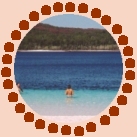
The reason we visited so many lakes and creeks for swimming, is that you can't swim in the ocean at Fraser Island, as there are not only sharks, but also poisonous snakes! This makes for a very odd beach setting: it's sunny, there's a wide, sandy beach, but there's no-one in the water, or even close to the surf!
We returned to Hervey Bay in the early evening.
Friday, september 6th, 2002.
We hadn't really planned on going whale watching in Hervey Bay, as we'd already gone whale watching off
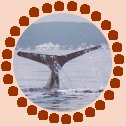 Vancouver Island, Canada, last year. However, the whales in Canada were gray whales, and the ones over here are humpback whales, and people convinced us it was something we shouldn't miss. This was supposed to be the height of the whale-watching season, so we joined a whale watching trip with Tasman Ventures, and didn't regret it for a minute! Tasman Ventures has a small boat, compared to most operators, and that's supposed to be an advantage, as you're less high off the water.
Vancouver Island, Canada, last year. However, the whales in Canada were gray whales, and the ones over here are humpback whales, and people convinced us it was something we shouldn't miss. This was supposed to be the height of the whale-watching season, so we joined a whale watching trip with Tasman Ventures, and didn't regret it for a minute! Tasman Ventures has a small boat, compared to most operators, and that's supposed to be an advantage, as you're less high off the water.
I must say, the humpbacks treated us to quite a spectacle! In Canada, we were thrilled to see the tail of a diving whale - here we were treated to several hyper-active humpbacks that just wouldn't stop breaching! It was a sight to see. A whale
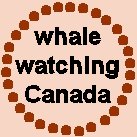 would be lounging on his back, slapping his flippers onto the water surface every now and again ("backflapping"), and then decide to go for a dive. We'd see his tail disappear below the surface. Then, 20 seconds later or so, the whale would come rearing out of the water ("breaching"), lifting about 3/4 of his entire length above the waves, and crash back down onto the surface with an enormous splash! One particularly active male was really in a backflapping - breaching mode; I think we must have seen him breach fifteen times, it was absolutely awesome.
would be lounging on his back, slapping his flippers onto the water surface every now and again ("backflapping"), and then decide to go for a dive. We'd see his tail disappear below the surface. Then, 20 seconds later or so, the whale would come rearing out of the water ("breaching"), lifting about 3/4 of his entire length above the waves, and crash back down onto the surface with an enormous splash! One particularly active male was really in a backflapping - breaching mode; I think we must have seen him breach fifteen times, it was absolutely awesome.

We also followed a "pod" of three whales for a while. They were two "mile whiles" and a "femile," as the guide put it. I would have liked to hear him say "there's a male whale a mile away." We were cruising parallel to these "whiles," hoping they might breach, when they surprised us, made a turn, and came right for us! Wow, two of them swam right around the back and below the stern of the boat, and one went underneath the bow! As they passed slowly underneath us we could see up close just how large they are.

The humpback whale watching trip was something I wouldn't have wanted to miss. Do it if you happen to be there in the right season! In the late afternoon we drove from Hervey Bay to Bundaberg, for a little more ocean adventure on our
diving trip at the Great Barrier Reef.
Where we stayed:
Caravan parks:
Hervey Bay: Fraser Lodge Caravan Park - excellent, with pool
Fraser Island: Eurong Beach Resort
Operators:
Fraser Island trip:
Fraser Island Adventure Tours
(2 days, 1 night at Eurong Beach Resort)
Whale watching trip:
Tasman Ventures, half day
We were very happy with both operators.
Photographs - Fraser Island
& Hervey Bay
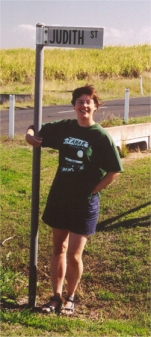
So this is where I'm from
!
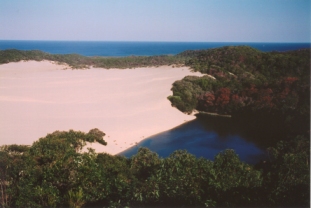
Lake Wabby (Fraser Island).
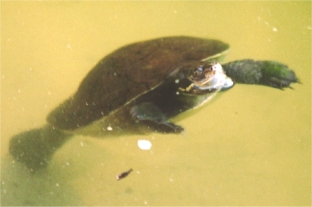
Turtle in Lake Wabby (Fraser Island).

Turtle in Lake Wabby (Fraser Island)
.
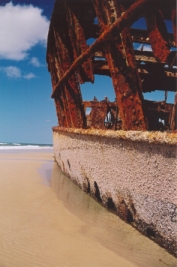
Wreck of the Maheno, on Fraser Island beach
.

Eli Creek (Fraser Island).
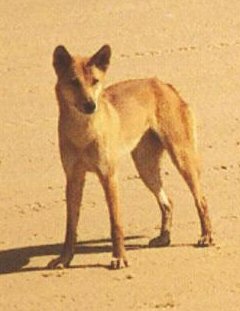
Dingo (Fraser Island)
.

Lake McKenzie (Fraser Island)
.

Diving humpback whale's tail (Hervey Bay)
.
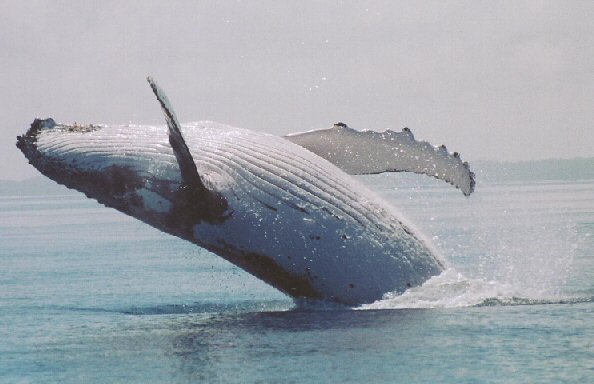
A breaching humpback whale...
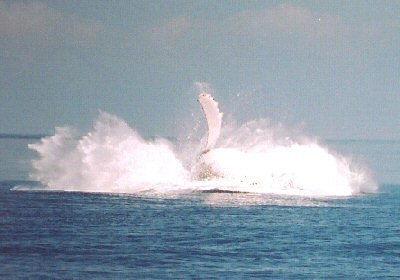
... and this is the splash they land with!
(Hervey Bay)
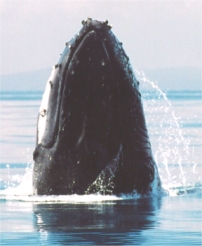
A humpback taking a peek above the water (Hervey Bay).

Two "mile whiles" cruising about. The one on the right is
just diving, the other is lying on his back, flopping
his fins (Hervey Bay).
|Judith home|
|Canada|
|Portugal & Spain|
|Sweden|
|Nepal|
|cycling Holland to Spain|
|
email me|
|


